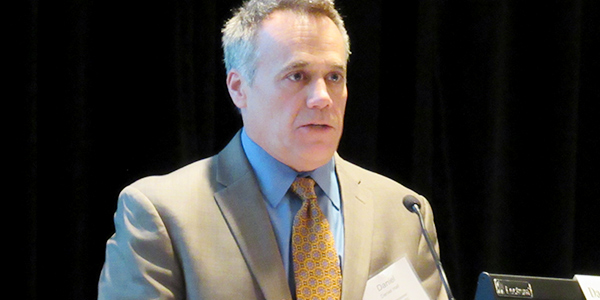By Amanda Durish Cook
CARMEL, Ind. — State regulators in MISO and SPP are making progress on the seams issues that continue to vex the RTOs, but much work remains, MISO stakeholders learned Tuesday.
The Organization of MISO States (OMS) and SPP’s Regional State Committee (RSC) have been meeting since mid-2018 to discuss interregional coordination, which has never produced a major project, frustrating some stakeholders and causing market inefficiencies. Regulators last year initiated meetings with RTO officials to ask for solutions. (See Regulators Examine MISO, SPP Seams Issues at NARUC.)
The RTO’s market-to-market process has resulted in more than $51 million in payments from MISO to SPP since March 2015, compensation paid to manage congestion at the seam. The grid operators also face possible renegotiation next year of the 2016 settlement agreement addressing compensation for energy transfers between MISO Midwest and South above the current 1,000 MW of contract path capacity on SPP transmission.
Speaking during a Jan. 22 update at MISO’s Informational Forum, Missouri Public Service Commissioner Daniel Hall said the RTOs experience “significant inefficiencies on the seams” that are both “philosophical and structural.”
“There’s a growing awareness that these seams issues are becoming more significant due to the diminishing reserve margins,” Hall said, adding that some “personality issues” between MISO and SPP staff may have contributed to past difficulties.
Hall said regulators from both regions have outlined goals of improving seams coordination through:
- Better market-based transactions and operations across the MISO-SPP seam;
- Equal consideration of “beneficial regional and interregional projects in transmission planning”;
- “Timely interconnection of new resources that includes consideration of the dynamics of the interconnection queue in both RTOs”; and
- Improved inter-RTO relations through state-led cooperation.
“There’s nothing earth-shattering here,” Hall said of the OMS-RSC coordination effort. “We want to reduce transmission constraints to benefit ratepayers.”
“No one is right or wrong where viewpoints don’t align. We strive to understand the drivers behind our differences. It’s not personal. … The best outcome for customers is the best outcome. Customers in all portions of an RTO footprint should benefit from RTO membership,” Hall said.
While Hall said the RTOs are already working on several coordination issues such as better emergency coordination and easing interregional project criteria, some seams issues — including regional through-and-out rates and pseudo-tied generation — are being left unaddressed.
OMS and RSC representatives will meet again in D.C. on Feb. 10 in conjunction with the National Association of Regulatory Utility Commissioners winter meeting. Hall said the two groups will discuss the need for additional questions for both RTOs and explore the possibility of requesting a FERC analysis or commissioning an independent analysis on the MISO-SPP seam.
MISO Plans Seams ‘Hot Topic’ Talk
RTO seams issues will feature as MISO’s first 2019 “hot topic” in-depth stakeholder discussion in March. Staff said the goal is to get policy-level input from stakeholders on how to best approach coordination with its neighbors.
Jeremiah Doner, MISO director of seams coordination, said the RTO’s physical central position in the Eastern Interconnection “introduces a number of different regulatory and structural models that we have to work with.” He cited the 11 separate RTOs, independent utilities, cooperatives and federal agencies that border their territory and have varying seams coordination agreements with the RTO.
Doner said MISO is looking for stakeholders to offer views on what they would consider optimal coordination and a more consistent model for seams coordination with both RTO and non-RTO neighbors. MISO would look to improve price formation, transmission planning and cost allocation along all its seams, he said.
Customized Energy Solutions’ David Sapper asked how MISO might improve its transmission sharing with SPP so that South capacity is not trapped because of the contractual limit on SPP transmission connecting that region with Midwest.
Doner said MISO is open to discussing changes to the contract governing the Midwest-South contract path, which can be altered beginning in 2021.
In a separate monthly market operations report delivered at the meeting, MISO said it is monitoring additional generation committed for capacity that became trapped behind the contractual constraint in December. MISO Executive Director of System Operations Renuka Chatterjee said the capacity wasn’t ultimately needed because load did not materialize.
MISO load averaged 75.5 GW in December and load peaked at 94.2 GW on Dec. 11. Chatterjee said it was a mild month for the RTO, except for a few cold days at the beginning. Rising coal and natural gas costs lifted real-time prices to an average $31/MWh, she said, up 21% from a year earlier.





